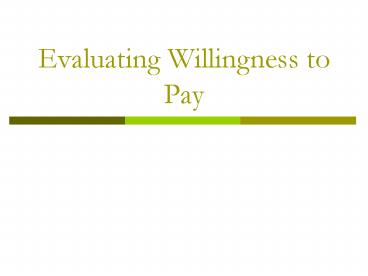Evaluating Willingness to Pay - PowerPoint PPT Presentation
1 / 25
Title:
Evaluating Willingness to Pay
Description:
An individual's marginal WTP may exceed market price (consumer surplus) ... Great day for skiing! Same price! Who benefits? Why doesn't everyone ski? ... – PowerPoint PPT presentation
Number of Views:567
Avg rating:3.0/5.0
Title: Evaluating Willingness to Pay
1
Evaluating Willingness to Pay
2
Evaluation
- Process of measuring the benefits derived from
the use of a resource in monetary terms
3
Opportunity cost method
- Among a group of alternative uses of a resource,
the value of the chosen use is at least equal to
the benefits that would have been derived from
the next best alternative.
4
Willingness to Pay method
- In an economy based on monetary exchange, the
individual's willingness to pay a amount tells
us that the amount paid is worth the sacrifice of
the other things that could have been purchased
with the money.
5
Total v. Marginal WTP
- Total WTP is the total amount an individual would
be willing to pay for a particular quantity - area under the demand curve
- Marginal WTP is what an individual is WTP for
additional units - Illustrated by a curve
6
About WTP
- Marginal WTP diminishes with quantity (Law of
demand) - An individuals marginal WTP may exceed market
price (consumer surplus) - If an individuals marginal WTP is less than
market price, individual will not buy
7
About WTP for skiing
- How much is the first day of ski trip worth? The
second? The fifth? - Great day for skiing! Same price! Who benefits?
- Why doesnt everyone ski? What if the price goes
down?
8
Total v. Marginal WTP for skiing
- What was that ski trip worth? gt total
willingness to pay - What was the first day worth? The fifth day? gt
marginal willingness to pay
9
Marginal WTP curve
- Downward sloping
- Price elasticity
- measures how responsive consumers are to price
change - Percentage change in quantity demanded /
Percentage change in price - ?Qd / ?price
10
Price elasticity example
- If Ed .6 a 10 change in price brings about a
6 change in quantity demanded. - If Ed 1.4, a 10 change in price brings about a
14 change in quantity demanded. - Whenever
- Ed lt 1 demand is inelastic
- Ed gt1 demand is elastic
11
Elasticity and Total Revenue
- What happens to total revenue when price
decreases? - Lower price ? producers get less for each unit
sold ? total revenue declines - Lower price ? increases quantity demanded ? total
revenue increases - Overall impact of lower price on total revenue
depends on the net result of these opposite
effects - If demand is inelastic, a firm that raises it
price will find that total revenue increases - If demand is elastic, a firm that raises its
price will find that total revenue decreases
12
Total WTP area under MWTP curve
- Pricequantity consumer surplus for a
particular quantity - Pricequantity total revenue, observed in
market place - Consumer surplus area above price below MWTP
curve, unobserved
13
Inframarginal WTP for a large change in quantity
14
Increase in marginal WTP for a quantity
- additional area under the new curve for a
particular quantity
15
Aggregating WTP among buyers
- Market value depends on the values of all buyers
- Add quantity at each price for each buyer
16
Solved problem 1 movement along WTP with a
change in price
- Quantity (acres) 20 - .04Price per acre
- Find quantity for prices from 500 to 0
- Plot marginal WTP
- Find consumer surplus and total willingness to
pay for 4 acres - Find total willingness to pay for 2 additional
acres
17
Marginal WTP equation and table
Quantity (acres) 20 - .04Price per acre
18
Marginal WTP curve
19
Total WTP area under curve
- total revenue rectangle consumer surplus
triangle - 4400 0.54100
- 1600 200
- 1800
20
Find total willingness to pay for 2 additional
acres
- Area under MWTP from Q4 to Q6
- Divide into two areas rectangle and triangle
- (6-4)350 0.5(6-4)(400-350)
- 750
21
Solved problem 2 - shift in entire WTP function
- New Quantity (acres) 20 - .04Price per acre
- Find the increase in the Total WTP for a quantity
of Q4 with the increase in the MWTP.
22
Increase in marginal WTP for a quantity
additional area under the new curve
23
Increase in total WTP increase in area under
new curve
- area of triangle area of triangle
- .51004 .51004
- 400
24
Solved problem 3 Aggregating WTP among buyers
25
Solved problem 3 Aggregating WTP among buyers

